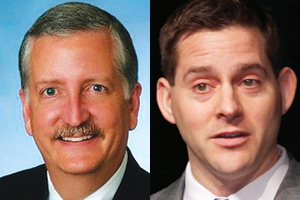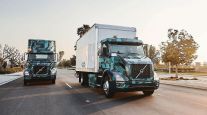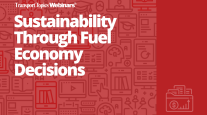Senior Reporter
Trucking Cautious as Greenhouse-Gas Plan Attracts Support, Outcry at Federal Hearing

The sweeping federal proposal to cut greenhouse-gas emissions and raise fuel efficiency for medium- and heavy-duty trucks over the next decade prompted qualified support, an outcry over poor air quality and calls for zero-emissions technologies at a public hearing Aug. 18 in Long Beach, California.
The U.S. Environmental Protection Agency and the National Highway Traffic Safety Administration issued the proposal in June.
Daniel Kieffer, director of emissions compliance at truck maker Paccar Inc., called the proposal “historic in its scope and complexity.”
It would regulate a broad range of over-the-road tractor applications, plus several kinds of vocational trucks, buses and motor coaches, he said. As proposed, the rule would have separate standards for trucks, engines and trailers.
Daimler Trucks North America, Navistar Inc. and Volvo Trucks also had representatives at the hearing, but they deferred to Kieffer to offer joint comments.
“We will do everything we can to ensure this regulation will translate into real-world efficiency for our customers as well as major benefits for society. Our goal is a classic win-win scenario, and we are hopeful we can achieve it,” Kieffer said.
But challenges remain, he added.
“Minimizing the total cost of vehicle ownership is at the top of the priority list for our customers,” he said.
However, when it comes to doing so with better aerodynamics, for instance, that path is not clear because measurement and analysis of tractor-trailer aerodynamics is extremely complex, he said.
“For now, we would like to emphasize that significant aerodynamic improvements can only be achieved by treating the tractor and trailer as a system,” Kieffer said.
The proposal has separate standards for trailers beginning in 2018.
He said even SuperTruck designs — part of a Department of Energy demonstration project — could not achieve the tractor aerodynamic targets if tested according to the proposal’s requirements.
“These details must be addressed,” Kieffer said.
EPA and NHTSA intend to cut GHG emissions overall by about 1 billion metric tons, conserve about 1.8 billion barrels of oil and lower fuel costs by about $170 billion over the lifetime of the vehicles sold under the phased-in program that takes full effect in 2027.
The proposal does not go far enough, or fast enough, to satisfy some clean-air advocates from California, many areas of which have some of the worst air quality in the nation.
Jim Stewart, representing the Los Angeles branch of the Sierra Club, pleaded for EPA and NHTSA to act faster saying that “over the past year more than 5,000 Californians have died from unhealthy air quality.”
Mary Nichols, chairwoman of the California Air Resources Board, asked the agencies also “to pursue a mandatory lower nitrogen oxide engine standard nationally.”
She said the nitrogen oxide rule for 2010 and later engines is not low enough and called for a new one for future engines.
Trucks emit one-third of the state’s overall nitrogen oxide emissions, she said, and asked for changes in the agencies’ proposal to boost reliance on zero-emissions technologies.
“Unfortunately, the Phase 2 proposal is not stringent enough to drive market development of hybrid, electric or fuel cell technology,” Nichols said.
Fleet executive Michael O’Connell said the proposal’s approach to evaluate current and future technologies’ adoption into the industry with an average two-year payback is “a fair assumption. It creates a standard built on fact and grounded on logic.”
However, O’Connell, senior director of fleet supply chain for Frito-Lay North America Inc., a division of PepsiCo, said financial incentives are necessary to help fleets adopt cleaner strategies.
The current proposal has no incentives for adoption of cleaner technologies, he said, and urged they be added.
Earlier incentives helped Frito-Lay build one of the largest private electric-vehicle fleets in the nation, he said.
Brian Mormino, executive director for environment and compliance at Cummins Inc., said the engine maker spent 3½ years providing “extensive policy and technical input” to the two agencies leading up to the 1,329-page proposal.
But he strongly objected at the hearing to the proposal’s requirement that would have Cummins certify a steady-state engine fuel map — which can calculate fuel use in simulations of driving cycles — and provide it to truck makers for use in the greenhouse gas-emission model certification process.
That requires “Cummins to release proprietary and confidential business information into the public domain,” Mormino said.
Proposed engine standards begin in model year 2021, increase in 2024 and become final in 2027. They would reduce greenhouse-gas emissions and fuel consumption by 4% compared with Phase 1.
The federal agencies held an initial meeting Aug. 6 in Chicago. Written comments on the GHG proposal are due Sept. 17. The final rule is expected in the spring of 2016.




